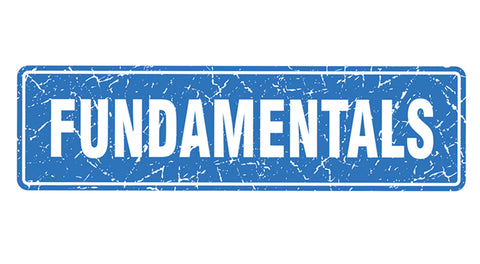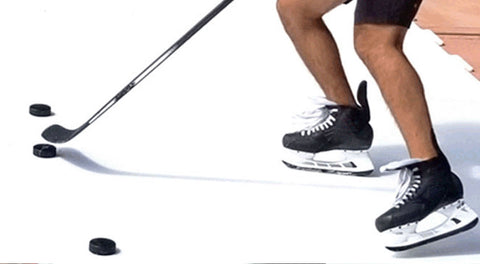10 Tips to Become a Skilled Hockey Skater on Synthetic Ice
Hockey is a sport that requires strength, speed, agility, and accuracy.
It can take years to develop these skills, and only a chosen few make it to the peak of the sport.
When it comes to training, any advantage counts.
Synthetic ice is a great, versatile option for ice skating. It's also an excellent surface to become a skilled hockey player.
pull their hair out when it happens.
IMPROVE YOUR SKATING AT HOME WITH POLYGLIDE SYNTHETIC ICE
More hockey players are investing in synthetic ice to improve specific skills to make them faster and more agile on the ice.
We've gathered some tips you can use to level up whether you have your own piece of synthetic ice at home or you're visiting a rink to practice.

Synthetic in Material, Natural in Performance
Hockey games are played on natural, refrigerated ice, which combines water and coolant on a specially designed surface, which is then powered by refrigeration to maintain the ice's temperature.
It's the only approved surface for competitive hockey games.
However, there are other surfaces you can skate, train, and compete on, like synthetic ice.
Synthetic ice consists of white sheets or panels of a unique polyethylene material.
The best synthetic ice panels are reinforced with a slip-sliding agent.
Therefore, you can use your metal blades to skate on the surface.
Synthetic ice comes in pre-cut panels that connect at each edge to form the synthetic ice surface.
With enough panels, you can create a large enough ice skating or hockey space for training with your teammates.
Hockey players and enthusiasts were concerned about using synthetics to play games.
The material, they argued, had too much friction and did not feel the same as natural ice.
While there is some truth, synthetic ice has transformed over the years - thanks to improvements in technology and manufacturing – to have a low coefficient of friction that feels similar to real ice.
There are even conversations about perhaps playing an NHL game on synthetic ice.
Synthetic ice finds its home in recreational use in holiday rinks at malls, hotels, and carnivals.
Today, you can find it in backyards and basements, thanks to its customizable abilities.
Synthetic ice is also a fantastic tool for training. Hockey players, in particular, see immense value in having at least one large panel at home or at a training ground.
When used the right way, the surface can have a significant impact on a hockey player's skills and training routines, especially when it comes to being a skilled hockey skater on synthetic ice.
Here are ten tips that can help you become better come game time.

1. Focus on the Fundamentals
Hockey is all about fundamentals, and the biggest foundation is becoming a more-than-competent skater.
Coaches, parents, and peers would have taught you the basics to help you reach your current level.
Everyone should work on the fundamentals, including NHL stars.
Synthetic ice helps you reinforce essentials like the right stance, positioning, skating speed, and much more.
Pick a skill and work on it daily using your private synthetic ice setup.
2. Improve Your Shots
What does shooting have to do with becoming a skilled hockey skater?
Everything.
You can skate well but must control the puck and get your shots off quickly and accurately.
With your skates on while on synthetic ice, you can practice wrist shots, slap shots, and backhands.
You'll need some other basics, like pucks, a net, and a rebounder dasher curb on your rink to practice shots.
Add obstacles and set up targets to make your shots more challenging as you skate toward the puck.
The more you shoot, especially when you have spare time, the more accurate and powerful you become. Just ask Steph Curry.

3. Develop Your Agility
Hockey players must also have exceptional agility. The ability to move quickly, change direction, and do so with ease are qualities recognized by the best coaches.
To become an excellent player, you'll need to out-hustle your opponent.
Becoming more agile can help you get there.
You can set up synthetic ice to perform shuttles, turns, and other key exercises that enhance your reaction time, fast-twitch muscles, and overall agility.
Some common examples include figure-eight drills, improving your pivot, and skating from uncomfortable angles. Have a coach develop a training plan that works well with your synthetic ice.
4. Synthetic Ice for Edge Work
Edges on ice skates play a crucial role in a hockey player's speed, balance, change of direction, and control.
Hockey skates have inside and outside edges that help the player turn in the desired direction.
It can take even more experienced hockey players several years to develop great edge work.
A synthetic ice rink, especially in your own home, helps you to work on mastering your inside and outside edges.
You can practice multiple edge work drills both with the stick and without. Then, do so faster. Then, aim for more accuracy. Then, more power and control.
Mastering your edge work is the key to speed and balance, giving you an advantage over your opponent.

5. Leverage Its Unique Advantages
Synthetic ice can make you a skilled hockey skater, thanks to its unique features.
Its versatility means you can set a rink up anywhere that has a flat surface area.
Whether it's your garage, driveway, basement, or backyard, you always have a space to hone your skills.
You can also use synthetic ice throughout the year.
When everyone is resting during the summer, you're working thanks to its flexibility.
By simply leveraging these advantages, you'll be a better, stronger skater.
6. Level Up Your Puck Handling
Skating while maintaining close control of the puck automatically makes you a more competent, competitive hockey player.
Slap on your skates and get in some puck-handling drills, which in turn makes you a skilled hockey skater.
Create your own circuits and shooting drills, or ask your coach for a custom plan.
Perform drills that help protect the puck, shoot, and control the puck in close spaces.
Do these while constantly moving to get better at skating on synthetic ice, which will transfer to natural ice.
7. Get Better Endurance and Conditioning
Strength and endurance are the assets of the skilled hockey skater.
Hockey players are always active in a competitive game, burning over 600 calories per hour.
You can build your endurance with off-ice exercises such as running.
But you'll need to do it on the ice, too.
With synthetic ice, you can practice shuttles, set up agility drills, and build your engine both indoors and outdoors under various conditions.
8. Experiment With Your Special Moves
Hockey players are known for developing skills and moves that are unique to them.
These skills give them an advantage when it comes down to crunch time.
Synthetic ice gives you the time to practice shooting from difficult angles and skating under certain conditions.
If your idol has a move you've been wanting to work on or perfect, your synthetic ice rink is the perfect space to do it.

9. Crossovers and Transitions
Crossovers are skill moves that allow you to increase your speed, navigate traffic on the ice, and move laterally.
Performing crossover drills can perfect these attributes.
Set up a series of cones or markers and practice crossovers around each cone, trying to get faster and more accurate each time.
Transitions are also a vital part of hockey, as the direction of play is constantly changing, and you'll need to turn quickly to catch up and influence the game.
Synthetic ice is great for transition exercises, so you can perfect backpedaling, turning, leaning, and getting up quickly when the moment calls for it.
10. Put in the Reps
Becoming great at any sport requires you to practice. It's what you do off the ice that will determine what you do on it.
Above all, synthetic ice allows you to become a skilled hockey skater by eliminating excuses.
You have a readymade skating surface that is usable indoors and outdoors.
You can practice as much as you want, for as long as you need to, without having to find a rink.
This one investment can last for years and give you the priceless ability to put in hundreds, if not thousands, of reps every month.
Conclusion.
Becoming an excellent hockey player requires you to bring it every day in practice.
It also requires you to go the extra mile.
If you have the will, synthetic ice is the tool you need to give you the skill.
When you're not near the ice rink, or its in the off-season, you can build endurance, perfect your edges, improve your crossovers, and become better with the puck.
At PolyGlide Synthetic Ice, our rinks can stand up to the demands of the most seasoned hockey player.
Speak with us to work together on creating an at-home rink that will help you be prepared for the upcoming season.
Wherever you are, synthetic ice can give you the advantage to become a skilled hockey skater.





